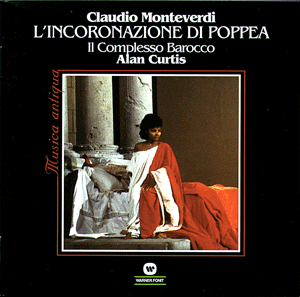At age 16, Monteverdi, already a fine organist
and viol player, entered the service of the Duke of Mantua as an instrumental
player and singer of madrigals. On military expeditions with the Duke
in 1595 and 1599 he heard, and was greatly influenced by, Florentine
operas and his first opera was produced in 1607. It is notable for the
fact that the action was for a full (by the standards of the time) orchestra.
After the death of his patron, Monteverdi became Master of Music of
the Venetian Republic in 1613. For St Marks he composed a stream of
sacred works by which his fame spread throughout Europe.
Several of Monteverdi’s early operas were irretrievably
lost in the sack of Mantua by the Austrians in 1630. However, his interest
in the genre was revived by the opening of Venice’s first opera house,
the San Cassiano in 1637. In the last six years of his life he composed
a series of works for the stage of which two survive, including Poppea
which was presented at the Venice Carnival in the autumn of 1642. The
operas of Monteverdi are the earliest works the opera-goer may expect
to see regularly staged.
Monteverdi set Poppea, his first on a historical
rather than biblical source, to a text by Busenello (after Tacitus circa
AD117). It comprises a Prologue and 3 Acts, and followed the traditions
of the day in that several male parts are sung at female pitch (by castrati),
a tradition that persisted in Italy for opera seria well into the 19th
Century.
The story, set in Rome around AD55, involves love triangles
and the triumph of love over morality; it might be summarised as ‘making
sin profitable’. It tells of how the Emperor Nero (Nerone, sop)
has fallen in love with the young Poppea (sop) who fancies being
Empress, a position held by Ottavia (mezz), the wife of Nero.
Nero wants to divorce Ottavia and when he tells his old teacher,
Seneca (bass), this, he is admonished by him. Poppea,
fearing Seneca’s influence, persuades Nero to condemn him to death.
Meanwhile Ottavia persuades Ottone (alto c-t) to murder Poppea
who, before being enamoured of Nero was his mistress, but he
is caught and only saved by Drusilla (sop) his lover who in turn
confesses her own intention to murder Poppea; she also reveals
Ottavia’s plot. The two lovers are banished, together, and Ottavia
is sent into life-long exile. Nero and Poppea are married and
she is crowned before the senate and populace. Love reigns supreme over
morality.
In the 20th Century, the seminal significance
of Poppea in the history of opera was realised and in the 1960s
productions, such as at Glyndebourne in 1962, were of fully orchestrated
versions with modern instruments and colourful continuo realisation.
Later these gave way to a simpler and more faithful style in which the
solo vocal line, the main expressive agent, received the chief emphasis.
Recordings of both approaches are available. For this recording of a
live performance given at La Fenice in Venice (now burnt down), Alan
Curtis has gone further and attempted a realisation as might have been
heard in 1642. This is easier said than done as no definitive score
exists. By researching what sources and texts do exist, deleting what
he believes are additions by Cavalli and amending other errors from
sources that do exist, Curtis claims to have got nearer the original
and that justifies this recording. He does admit this revision is only
one step in the direction of greater authenticity.
A live recording of a stage performance always poses
problems of balance and the first thing to say here is that they are
not mastered. This harpsichord and small orchestra are set well forward,
in a clear acoustic, while the voices are often too far back, lacking
presence and consistency of level. This is a pity as there are distinguished
performances to be heard, particularly by Carolyn Watkinson (Nerone),
Judith Nelson (Drusilla) and Carmen Balthorp (Poppea)
who are expressive and well differentiated in tone; all able to hold
the vocal line while giving vent to their emotions with appropriate
ornaments. The Ottavia of Andrea Bierbaum is well realised with
good tone and line whilst the Seneca is a little wavery rather than
solid; this latter could be deemed appropriate in an old man facing
death by his own hand. The alto c-tenor of Henri Ledroit (Ottone)
is a little breathy but he holds a good line which cannot be said of
the counter-tenor singing the fortunately small part of Amore.
The pacing of the performance seems natural and wholly appropriate.
There are a few, not very disturbing, stage noises.
The 3 discs are neatly divided— Prologue + Act 1; Act
2; Act 3. The accompanying booklet containing a libretto (no translation),
track listing, synopsis and a rather verbose essay. The vocal registers
are not given: those given are mine.
This is an issue for those with a special and determined
interest in this field. Ordinary opera-goers may wish to investigate
studio recordings of modern orchestral or other authentic realisations;
3 discs at even mid-price could be an expensive mistake.
Robert J Farr


